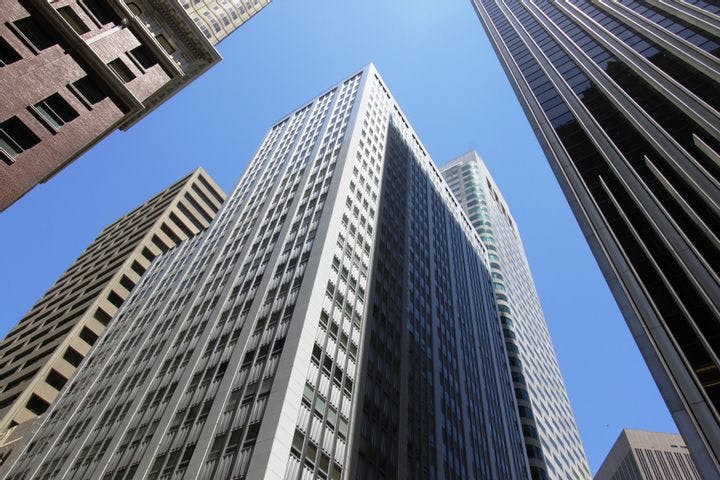Winter 2012
Building UP
– Jill Jonnes
Skyscrapers, a love story.
In 2006, as my family and I rode from the Shanghai airport toward the city’s downtown, our young guide proudly pointed out the multitude of luminous skyscrapers—dazzling in their shapes, jeweled colors, and sheer height—soaring into the night sky. For millennia, men and nations have striven to build the tallest edifices—from Egypt’s pyramids (the tallest originally reached 481 feet) to America’s art deco Chrysler Building (1,046 feet) to Dubai’s Burj Khalifa (2,717 feet)—as monuments to their advancing technology and supremacy. Shanghai’s 60-some-odd skyscrapers proclaim China’s status as a modern international powerhouse.
Today, in the entire world there are just over 500 skyscrapers (defined as buildings more than 600 feet tall). Hong Kong is the globe’s “tallest” metropolis; the combined height of its skyscrapers is triple that of New York City’s. In her illustrated guide The Heights, Kate Ascher, a real estate and development consultant and the author of The Works: Anatomy of a City (2005), details the history, design, and upkeep of these man-made marvels.
In the late 1880s, architects and builders in Chicago and New York City invented this ambitious architectural form, creating “cathedrals of commerce” to address the need for office space in congested downtowns where real estate prices were at a premium. The skyscraper’s ever greater heights were possible only because electricity had supplanted gaslight, cities had developed water and sewage systems, and, above all, because in the 1880s the electric motor was incorporated into inventor Elisha Otis’s “safety elevator,” whose basic principles of cables, counterweights, and a catch system still govern the lifts that zoom us skyward.
Wind remains such a significant factor in skyscraper design that a building’s aerodynamics must be simulated and tested in wind tunnels. Miscalculations can be calamitous—Boston’s 60-story John Hancock Tower gained notoriety in the 1970s when winds exceeding 45 miles per hour caused its 500-pound windows to pop out and crash to the ground.
Though few of us have heard of structural engineer Fazlur Khan, in the 1960s he revolutionized skyscraper construction by devising a framing system around a tubular core that increased structural stability, allowing buildings to “rise to unprecedented heights,” Ascher writes. The World Trade Center towers were among the first framed-tube structures. On 9/11, the fuel-laden passenger jets that struck the towers dislodged asbestos sprayed on the steel support beams to protect them from heat. In the intense fire that followed, the beams weakened and buckled, causing both buildings’ swift collapse.
Skyscrapers reflect the societies whose needs they are constructed to serve: In the United States, short commercial leases (typically 15 years) mean that large, flexible floor plans prevail, so that space can be easily converted for different uses. In Europe, where workers by right cannot be more than 25 feet away from natural light, the resulting narrow buildings often also have natural ventilation. In Japan, the country’s frequent earthquakes dictate bulky, wide structures. In India, where chronic water shortages and inadequate infrastructure require some skyscrapers to receive drinking water on trucks, water from toilets, showers, and sinks is processed in graywater distribution systems for the buildings’ flushing and irrigation needs. Many Western skyscrapers cater to superstition by having no 13th floor. In China, Ascher notes, the number four “sounds like the word for death, and thus carries a negative connotation.” So some skyscrapers just skip floors 40 to 49, as well as 14, 24, 34, and so on. Another fun fact: If all 445 tons of paper recycled in 2008 by workers in Chicago’s Sears Tower had been stacked up, each week the resultant pile would have equaled the building’s height.
With more than half of the world’s seven billion people jammed into urban cores, skyscrapers are now often designed as mixed-use “vertical cities.” Ascher shows what an efficient use of space these buildings can be. A typical suburban landscape comprising 135,000 square feet of strip-mall retail space, 225,000 square feet of residential development on quarter-acre lots, and 875,000 square feet of office space in five- and six-story buildings with adjoining parking lots would take up the equivalent of 21 square blocks in New York City. Yet all of these activities and functions can be accommodated in a skyscraper occupying a little more than half a typical Manhattan block. More of us work (and live) in skyscrapers than ever before. Ascher delivers an engaging guide to these amazing structures.
* * *
Jill Jonnes, a Wilson Center public policy scholar, is the author of Eiffel's Tower (2009) and Empires of Light (2003), among other books. Reviewed: "The Heights: Anatomy of a Skyscraper" by Kate Ascher, Penguin Press, 2011. Photo courtesy of Flickr/OZinOH
